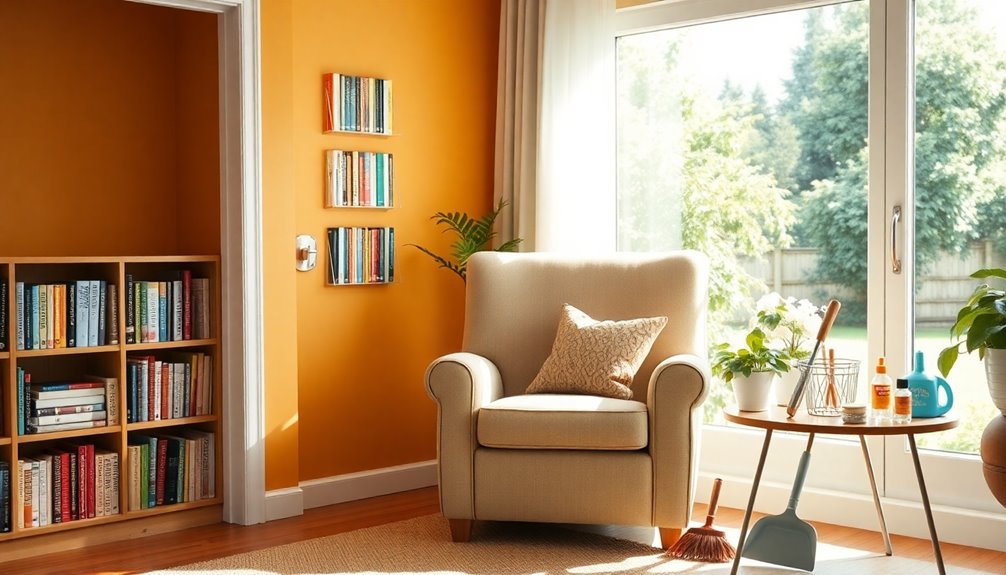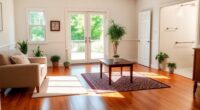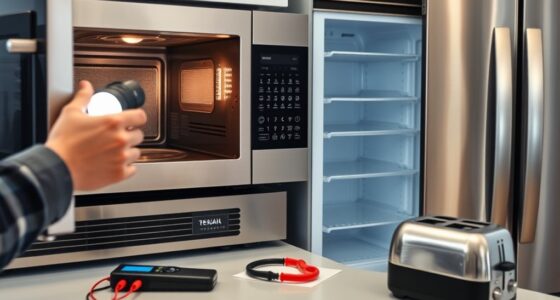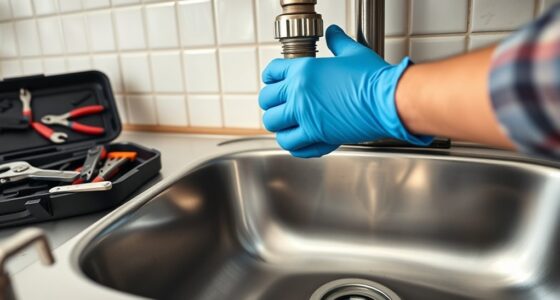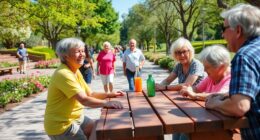To prolong the life of senior-friendly homes, make regular safety inspections a priority, and maintain clear pathways and floors to prevent trips. Don't forget to check and replace smoke alarms, carbon monoxide detectors, and HVAC filters. Guarantee proper lighting throughout your space and keep mobility aids well-maintained. Perform routine kitchen and bathroom checks to promote hygiene. By following these tips, you'll enhance comfort and safety, and there are more valuable insights waiting for you ahead.
Key Takeaways
- Conduct regular safety inspections and document findings to prioritize necessary repairs, enhancing accessibility and safety for seniors.
- Maintain clear pathways and floors, securing rugs and ensuring clutter-free areas to prevent slips and falls.
- Regularly replace HVAC filters and control humidity to improve air quality and reduce mold growth in the home.
- Inspect mobility aids frequently for wear and tear, ensuring they are clean and functioning correctly for user safety.
- Ensure adequate lighting throughout the home, using brighter bulbs and motion-sensor lights for enhanced visibility and safety.
Conduct Regular Safety Inspections

To guarantee a safe living environment for seniors, conducting regular safety inspections is essential. Aim for at least two inspections per year to identify hazards like loose handrails or worn-out grab bars that could lead to falls.
Use a thorough checklist to evaluate all areas of the home, including bathrooms and staircases, ensuring you cover all safety features. If your elderly family members face considerable mobility challenges, consider engaging professionals for detailed assessments; they can suggest tailored home modifications.
Document your findings and prioritize necessary repairs to create an accessible environment. By addressing these issues promptly, you'll greatly reduce the risk of accidents and injuries, helping your loved ones live safely and comfortably at home.
Maintain Clear Pathways and Floors
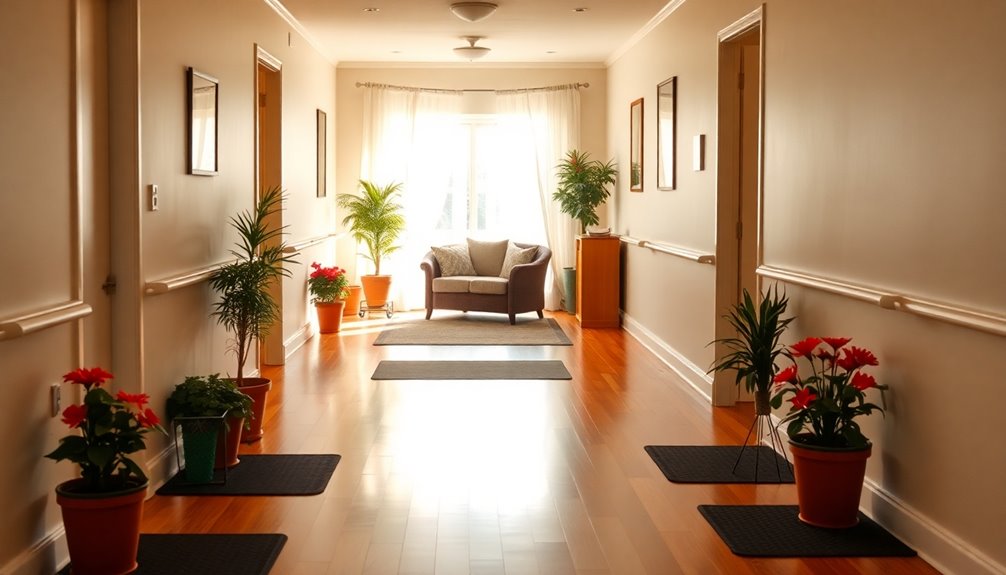
Maintaining clear pathways and floors is essential for preventing accidents in a senior-friendly home. Regularly inspect your space for tripping hazards like loose rugs, electrical cords, and low furniture.
Secure area rugs with non-slip backing, especially in high-traffic areas like kitchens and entryways. Keep walkways free of clutter to guarantee easy navigation for individuals using mobility aids, aiming for at least 36 inches of clear space for wheelchair accessibility.
Schedule routine cleaning to maintain flooring and quickly address spills to prevent slips. Finally, assess your flooring materials; replace worn or slippery surfaces with textured options like rubber or vinyl to enhance safety and accessibility for seniors.
Taking these steps can greatly reduce the risk of accidents.
Check and Replace Safety Systems
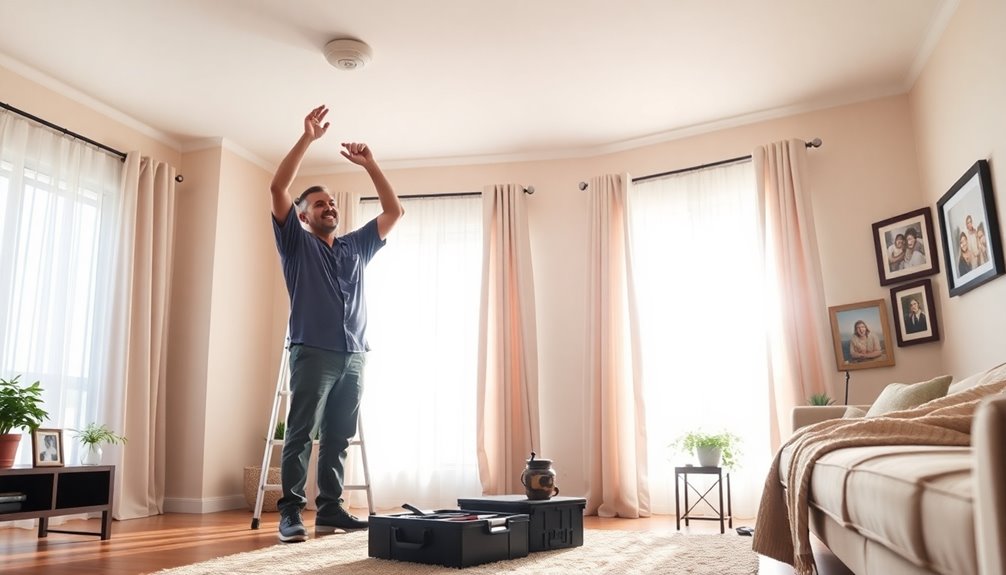
Guaranteeing your safety systems are in good working order is essential for preventing accidents in a senior-friendly home. Regularly test smoke alarms and carbon monoxide detectors at least once a month. Replace the batteries annually to maintain safety standards.
Inspect and replace outdated electrical outlets to prevent hazards. Schedule annual inspections of gas appliances and heating systems to guarantee they operate safely, reducing risks associated with leaks. Installing surge protectors can safeguard sensitive electronics, enhancing home safety.
Don't forget to replace damaged or frayed electrical cords immediately, as they pose significant fire and shock hazards. In doing so, you're not only prioritizing safety but also enhancing the overall health care and well-being of your loved ones in their home environment. Additionally, ensuring optimal performance of air purification systems can further contribute to a healthier living space.
Prioritize Air Quality Maintenance

To keep your home comfortable and healthy, prioritize air quality maintenance.
Regularly replace HVAC filters, control humidity, and guarantee your ventilation system is in good shape.
These steps help create a safer environment, especially for seniors who may be more sensitive to air quality issues. Incorporating air purifiers into your home can further enhance indoor air quality and provide relief from allergens.
Regular Filter Replacement
While you may not think about it often, regularly replacing HVAC filters is essential for keeping your home's air quality high, especially for seniors.
Dirty filters can trap allergens and pollutants, leading to respiratory issues that can be particularly harmful for those with pre-existing conditions.
It's recommended to change standard air filters every 1-3 months, but if you live in a high-pollen area or have pets, consider replacing them more frequently.
Clogged filters force HVAC systems to work harder, raising energy bills and risking malfunctions that could lead to costly repairs.
Using high-efficiency particulate air (HEPA) filters can capture 99.97% of airborne particles, providing extra protection and improving indoor air quality for seniors in your home. Additionally, regular software updates for HVAC systems can enhance their efficiency and ensure optimal air quality management.
Humidity Control Measures
Keeping your home's air quality in check goes beyond just changing filters; humidity control plays a significant role too. Maintaining indoor humidity levels between 30% and 50% can greatly enhance air quality and reduce mold growth, which is vital for seniors with health concerns.
Implement effective humidity control measures by utilizing dehumidifiers in moisture-prone areas like basements and bathrooms. Regularly check and clean your HVAC systems to guarantee they operate efficiently and help maintain ideal humidity levels throughout your home.
Additionally, installing exhaust fans in kitchens and bathrooms effectively removes excess moisture. Don't forget to monitor humidity with hygrometers, giving you valuable data to take timely action and protect your home's interior. Proper air quality management is especially important for senior health concerns, as it can mitigate respiratory issues and enhance overall well-being.
Ventilation System Maintenance
Maintaining your ventilation system is essential for ensuring a healthy living environment, especially for seniors.
Good air quality can greatly impact health and comfort. Here are key steps to prioritize:
- Clean HVAC filters monthly to reduce allergens.
- Schedule annual inspections by professionals for peak performance.
- Use air purifiers with HEPA filters in common areas.
Additionally, regular maintenance can help prevent acute kidney failure caused by airborne toxins that may affect sensitive individuals.
Ensure Proper Lighting Throughout the Home
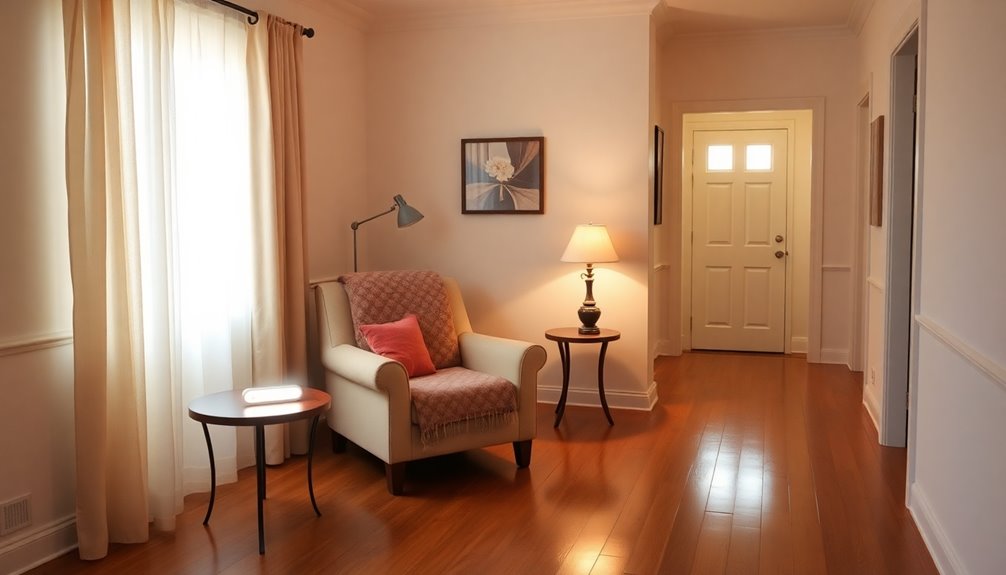
Ensuring proper lighting throughout the home is essential for enhancing safety and comfort for seniors. Improved visibility greatly reduces the risk of falls, especially in high-traffic areas like hallways and staircases.
Consider installing brighter bulbs, such as LED or compact fluorescent, to enhance illumination while being energy-efficient. Motion-sensor lights can automatically activate when someone enters a room, eliminating the need to fumble for switches in the dark.
Incorporate task lighting in kitchens and bathrooms to provide focused illumination where specific activities occur, minimizing shadows and increasing safety.
Regularly replace bulbs and keep fixtures clean and free from obstructions to maintain ideal brightness. Additionally, understanding critical periods for safe mobility can inform better lighting placement in frequently used areas.
With these steps, you'll create a safer, more comfortable environment for seniors in your home.
Regularly Inspect and Maintain Entryways
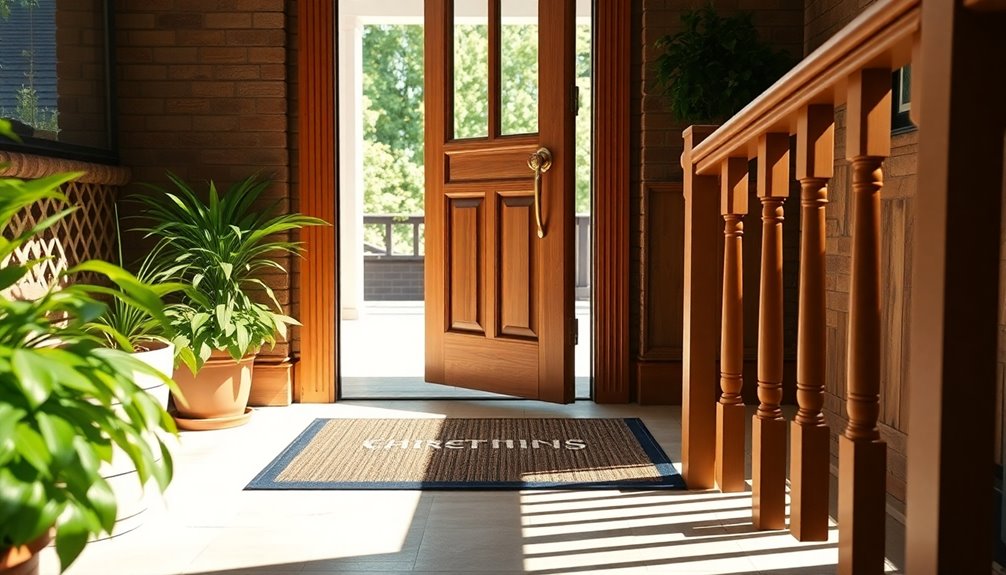
While you may not think about it often, regularly inspecting and maintaining entryways is essential for the safety of seniors and those using mobility aids.
Here are a few key aspects to focus on:
- Check for cracks or damage that could create tripping hazards.
- Confirm ramps are clear of debris and structurally sound.
- Keep pathways free of clutter to enhance accessibility.
Make certain the lighting at entryways is bright and functional to reduce fall risks.
Inspect door hardware, opting for lever-style handles that are easier for seniors to operate.
Update and Check Mobility Aids

To keep seniors safe and mobile, it's crucial to regularly update and check mobility aids like walkers and wheelchairs.
Start by inspecting these devices for wear and tear; any damage can compromise their support and safety. If you notice worn-out tires or wheels, replace them to guarantee smooth movement.
Don't forget to check the brakes—faulty brakes can lead to serious accidents. Additionally, make certain adjustable components, like seat heights or armrests, are set correctly for the user's comfort.
Finally, keep mobility aids clean and well-maintained; dirt and grime can affect functionality and lead to mechanical issues over time.
Regular attention to these details greatly enhances the safety of the home for seniors.
Perform Routine Maintenance on Kitchen and Bathrooms

Performing routine maintenance here can help prevent accidents and costly repairs. Consider these essential tasks:
- Regularly inspect for leaks in faucets and sinks to avoid water damage.
- Clean and descale showerheads and faucets every few months.
- Verify non-slip mats are in good condition to prevent slips.
Don't forget to check electrical outlets and appliances for safety.
Conduct thorough cleanings of exhaust fans and vents to maintain proper airflow and reduce moisture buildup. Additionally, keeping these areas clean and well-maintained supports a healthier lifestyle by promoting cleanliness and hygiene.
These steps will verify your kitchen and bathrooms remain safe and functional, prolonging the life of your senior-friendly home.
Schedule Periodic Home Safety Inspections

Scheduling periodic home safety inspections is essential for ensuring a secure environment for seniors. By regularly evaluating your home, you can identify potential hazards and create a safe and accessible space for aging in place.
These inspections reveal issues like loose railings, worn flooring, and inadequate lighting that may lead to falls or injuries. Engaging professionals for thorough safety evaluations covers at least 240 points, including bathrooms, kitchens, and entryways, ensuring no detail goes overlooked.
Monitoring safety features like grab bars and smoke detectors is crucial to maintain their effectiveness. Conduct these inspections at least once a year for peace of mind, confirming that your home environment remains safe and supportive for you and your loved ones. Additionally, consider incorporating pet therapy into your care strategies, as it can significantly enhance emotional well-being and reduce feelings of isolation for seniors.
Keep Outdoor Areas Safe and Accessible
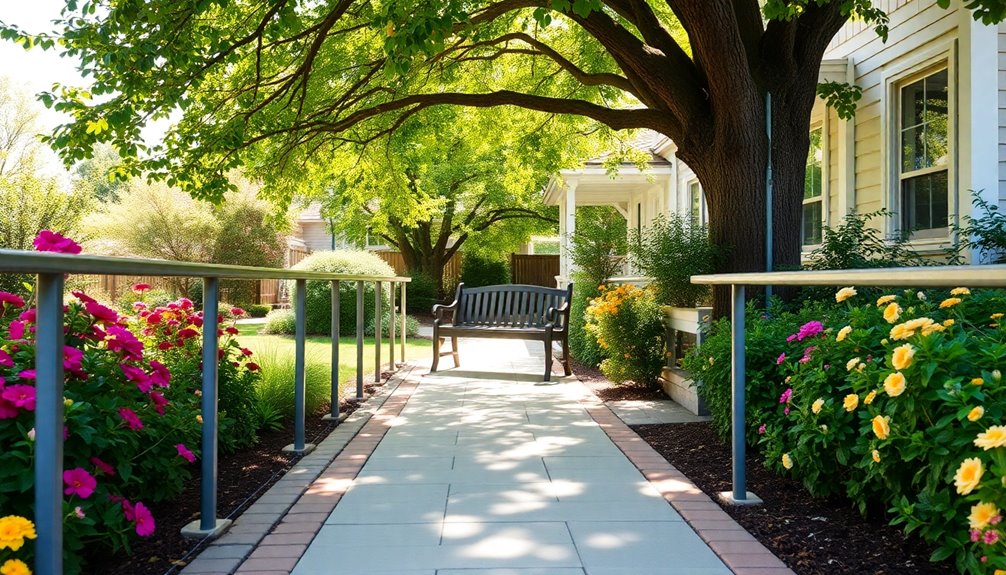
Maintaining safe and accessible outdoor areas is essential for seniors, as these spaces can greatly enhance quality of life.
To keep your outdoor areas secure, consider these tips:
- Regularly inspect pathways for cracks or debris to prevent tripping hazards.
- Trim back overgrown vegetation to guarantee clear access to entrances.
- Install non-slip surfaces on patios and walkways to reduce slip risks.
Additionally, make certain all outdoor areas are well-lit with motion-sensor lights, improving visibility for nighttime use.
You might also want to use raised garden beds or container gardening, allowing seniors to enjoy gardening without the strain of bending over.
Frequently Asked Questions
How to Make Your Home More Senior Friendly?
To make your home more senior-friendly, start by removing tripping hazards like loose cords and area rugs.
Install grab bars in bathrooms and along stairs for added support.
Consider accessible kitchen layouts with lower countertops for easy access.
Upgrade lighting in high-traffic areas to improve visibility and reduce accidents.
Finally, having a bedroom on the main floor can simplify access and reduce the need for traversing stairs, enhancing comfort and safety.
What Do Seniors Need to Stay in Their Homes?
Imagine your home as a cozy nest, where every detail nurtures comfort and safety. To stay in your beloved space, you'll need to guarantee it's free from tripping hazards and well-lit.
Installing grab bars and ramps can make navigation effortless. Regular maintenance keeps everything in shape, while smart technology offers peace of mind.
Don't forget the warmth of family and community support; together, they'll help you thrive in your cherished haven.
What Do Seniors Need the Most?
Seniors need safety and comfort the most.
You'll want to guarantee your home is equipped with features like grab bars, non-slip flooring, and adequate lighting to prevent accidents.
Accessibility is vital, so consider ramps and wider doorways if mobility is a concern.
Also, integrating smart home technology can enhance your independence and provide peace of mind.
Regular maintenance checks will help keep your environment safe and functional for years to come.
How Can I Help My Elderly Live Longer?
To help your elderly loved ones thrive like a well-tended garden, start by ensuring they get regular health check-ups.
Encourage them to engage in gentle physical activities, which can be as invigorating as a morning breeze. A balanced diet, rich in vibrant fruits and veggies, fuels their energy.
Foster social connections to dispel loneliness, and introduce cognitive exercises to keep their minds sharp.
In these ways, you can nurture their longevity and well-being.
Conclusion
By following these ten maintenance tips, you can truly enhance the safety and comfort of senior-friendly homes. Regular inspections, clear pathways, and proper lighting make a world of difference. You’ll not only prolong the life of the home but also create a nurturing environment for your loved ones. Remember, a little effort goes a long way in preventing accidents and ensuring peace of mind. So, take these steps today and enjoy a safer tomorrow! Additionally, it’s important to consider accessibility features, such as grab bars in bathrooms and non-slip mats in potential hazard areas. Incorporating these home maintenance tips for seniors can further aid in creating a supportive atmosphere that promotes independence and well-being. By being proactive and attentive to these details, you can significantly reduce the risk of accidents and enhance the overall quality of life for elderly residents in your home.
